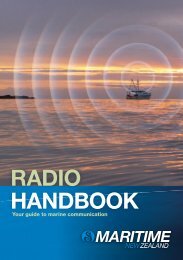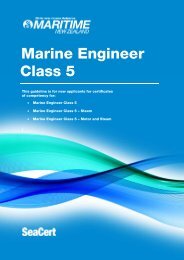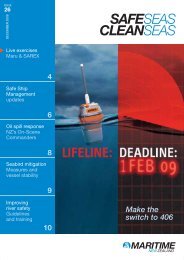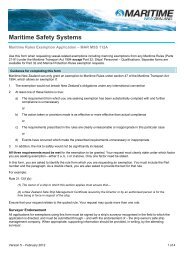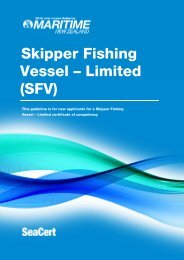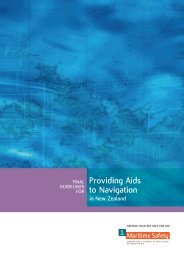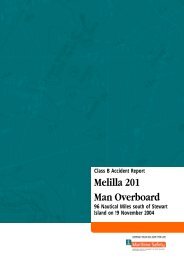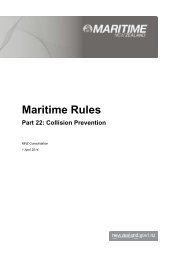Download - Maritime New Zealand
Download - Maritime New Zealand
Download - Maritime New Zealand
- No tags were found...
You also want an ePaper? Increase the reach of your titles
YUMPU automatically turns print PDFs into web optimized ePapers that Google loves.
[H1] <strong>Maritime</strong> news making waves in 2011The Rena grounding sparked intense media interest, with daily news conferences and media releases (over 200 in the first four monthsof the response).<strong>Maritime</strong> news makingwaves in 2011Searches in remote locations, tragic accidents and a dramatic grounding and oil spill wereamong the maritime and search and rescue events that dominated headlines in 2011,capping another busy year for MNZ staff. Here are some of the stories from last year…Collision tragedyThe year began with two seriousaccidents in two days involving youngpeople on small craft. One of theseended in tragedy.In the fi rst accident, at Tairua, in theCoromandel, two young people wereinjured following a collision between arigid-hull infl atable boat fi tted with a jetunit and an infl atable dinghy poweredby an outboard motor. A 16-year-oldand 12-year-old were on board theboat, and two 11-year-old boys wereon the dinghy.In the second accident, a 17-year-oldboy died after two jetskis collided onLake Okareka, near Rotorua. Two18-year-old men were prosecuted byPolice following an investigation intothe accident.Both accidents sparked inquiries byMNZ and Police, and the agenciesreiterated the need for personalresponsibility from all those in chargeof recreational vessels. This wasparticularly important during thesummer holiday period, a time ofheightened boating activity onthe water.After four days of searching, Police diversfound the teenager’s body.Southern Oceansearch effortLate on the afternoon of Tuesday,22 February, as the nation reeled withnews of earthquake devastation inCanterbury, a search was beginninghundreds of miles away for the crewof the Norwegian yacht Berserk. Thevessel was missing at the extremesouthern boundary of <strong>New</strong> <strong>Zealand</strong>’ssearch and rescue region.Well known in Norway for undertakingextreme and challenging voyages,the fi ve-man crew of the 48 foot(14 metre) steel-hulled sailboat waspart of an expedition aiming to makethe fi rst ice crossing to the South Poleon quad bikes.After dropping the skipper and acrewman onto the ice, somethingwent wrong on board the yacht.MARITIME NEW ZEALAND SAFE SEAS CLEAN SEAS MARCH 20125
An alert from its distress beacon,about 27 nautical miles (50 kilometres)north of Scott Base, was picked upby the Rescue Coordination Centre<strong>New</strong> <strong>Zealand</strong> (RCCNZ) and a massivesearch was launched for the yachtand its three crew.Vessels and aircraft from variousnations covered a calculated searcharea of more than 25,000 squarekilometres, braving extreme weatherconditions, including the area’sworst blizzard of the summer seasonfor many years. Altogether, theyspent 141 hours searching withoutsuccess for the missing yacht andcrew, making it one of the mostextensive conducted in the area. It isalso the furthest south that RCCNZhas conducted a search and rescueoperation.The Berserk just before itsdisappearance.Photo: Royal <strong>New</strong> <strong>Zealand</strong> NavyMicrolight mysteryRCCNZ was faced with anotherchallenging search and rescueoperation in April, when 86-yearoldmicrolight pilot Geoff Smaledisappeared during a fl ight betweenAuckland and Ashburton.The search began for Mr Smale, aformer Olympic yachtsman, afterhe failed to arrive at Ashburtonas scheduled. Up to 10 aircraft,including a plane and civil and militaryhelicopters, searched for two days forMr Smale and his high performanceaircraft, covering hundreds of squarekilometres along the route he wasbelieved to have taken.While Mr Smale was well preparedand his aircraft in good condition,rescuers had few clues about hislocation because he had not fi led aformal fl ight plan or checked in with airtraffi c controllers when crossing CookStrait, as he normally did.The search area covered about 1,300square kilometres and was centredover mountainous terrain betweenNelson and Blenheim. Rescuerscalled for the public to advise of anysightings or hearing reports of theaircraft. Pilots, air traffi c controllersand other aviation experts alsoprovided valuable information. RCCNZwas able to check the informationagainst radar tracking data suppliedby Airways Corporation. A number ofleads were generated, helping narrowdown the search.Soon after, a Royal <strong>New</strong> <strong>Zealand</strong> AirForce Iroqouis fl ying over Mt Duppa inthe Bryant Range located the crashedaircraft 20 kilometres east of Nelson.Sadly, Mr Smale was found dead atthe scene.Jet boat prosecutionIn May, a Queenstown jet boatcompany was prosecuted afteradmitting breaching maritime safetyrules by undertaking two commercialtrips on Lake Wakatipu in extremeweather conditions in December2009.Kawarau Jet was fi ned a total of$35,000 in the Queenstown DistrictCourt for three charges laid underthe <strong>Maritime</strong> Transport Act. Twocharges involved operating a vesselin a manner causing unnecessarydanger to those on board, and thethird charge was failing to report anincident to MNZ.On the fi rst trip, 17 passengers,including fi ve children, were soakedwhen a large wave swamped oneof the company’s vessels andincapacitated an engine. The incidentwas not reported to MNZ as requiredunder maritime rules and, despite thepoor weather conditions persisting,Kawarau Jet proceeded with asecond trip, this time without incident.MNZ’s Manager of <strong>Maritime</strong>Investigations, Steve van der Splinter,said that no other commercial tripswere operating on the lake thatday, but Kawarau Jet chose to goout twice, putting the lives of itspassengers and crew in danger.Close call for cutterAt a court hearing in July, acommercial master was convictedafter admitting a charge of failing tokeep a proper lookout. His actionscaused a serious collision with asailing vessel with 12 Outward Boundstudents on board.The former master of the PictonbasedDolphin Watch Ecotoursvessel Delphinus was ordered topay reparation of $4,400 for thecharge of failing to maintain a properlookout under the <strong>Maritime</strong> OffencesRegulations. It followed a collisionbetween the 12.9 metre commercialvessel and the 10 metre OutwardBound sailing cutter in February 2011between Picton and Torea Bay.In the collision, the bow of thecutter was sheared off and its masttoppled. Some of the studentsjumped overboard moments beforeimpact. MNZ’s Manager <strong>Maritime</strong>Investigations, Steve van der Splinter,said the accident could have hadfar more serious consequences andwas a reminder of the need for vesselmasters to be vigilant at all times.Twelve Outward Bound students endedup in the water after the Catamaran droveinto the cutter.Photo: Alison KelsoIn a separate prosecution, the samecompany was ordered to pay fi nesand reparations totalling more than$137,000 after admitting two chargesbrought by MNZ under the Health andSafety in Employment Act. It followedan investigation into a December 2010accident in which a passengersuffered life-threatening leg injuries.6 SAFE SEAS CLEAN SEAS MARCH 2012 MARITIME NEW ZEALAND
Rena – the challenge continuesIn January, Rena’s long-anticipated break-up triggered an immediate and intensive response on land and at sea.After balancing precariously on the Astrolabe Reef off Tauranga for three long months,Rena finally submitted to heavy seas in January, splitting into two sections. The cargoship’s long-anticipated break-up immediately triggered an intensive response on landand at sea.Containers and debris toppled into theroiling water as swells of more than7 metres battered the wreck. Salvageactivity was escalated along shorelinesand at sea, with response teams forbeach clean-up and oiled wildlifereactivated.Response plans were already wellestablished for Rena’s inevitablebreak-up. The ship was in a fragilestate from damage sustained whenit grounded on 5 October, and acrack was yawning open between itsforward and aft sections. In the daysleading up to the storm, electronicsensors had picked up extramovement in the ship. Transponderswere fi xed to vulnerable containersand others containing dangerousgoods, so they could be tracked if lostoverboard.The container recovery companyBraemar Howells set to work toidentify, tag, corral and collectcontainers and other debris spilledfrom the ship during the storm andbreak-up. Harbour channels andshipping routes were closely andregularly checked for submergedcontainers. Meanwhile, MNZreactivated its full oil spill responsecapability. The oiled wildlife facility atTe Maunga, which had been scaleddown, was scaled up ready for action.As the sea calmed and visibilityimproved, it became evident that theforward section of the ship was in itsoriginal position on the reef, but thestern section had separated by about30 metres, pivoting some 13 degreesclockwise. Days later, most of thestern slipped off the reef.Both sections are now open to thesea and extremely vulnerable to furtherdamage. The continual movementsof both sections with tidal fl ows, andincreased movement as containers areremoved and the ship grows lighter,are being closely monitored.The wildlife response was reactivated,in anticipation of a fresh release of oilfrom the broken ship affecting localpopulations of little blue penguins anddotterels. Fortunately, no signifi cantrelease of oil eventuated. Few birdswere affected and the facility wasprogressively demobilised duringFebruary. Rough conditions at the reefpersisted for several days, keepingthe salvage company Svitzer fromevaluating the ship’s status so it couldresume its work.For Svitzer’s recovery work at theship, the break-up brought new risksand challenges. Many containersare damaged and have to beindividually extricated in pieces fromtheir secure positions in the holds,where jagged metal and noxiousfumes from decayed goods presentserious hazards. Cutting and grindingthe containers and removing theircontents by hand is slow, labourintensive and dangerous.8 SAFE SEAS CLEAN SEAS MARCH 2012 MARITIME NEW ZEALAND
Clean-up operations underway at Matakana Island.Braema r Howells joined the Rena recoveryoperation soon after the vessel groundedoff Tauranga last October. The Britishbasedcompany has been responsible forrecovering damaged containers and cargo,and salvaging cargo from the stricken ship.The company was well prepared for its role. Its personnelhave previously worked with signifi cant maritime incidentsaround the globe, including the Deepwater Horizon andWest Atlas rigs and the vessels MV <strong>New</strong>castle,MV Fedra, MV <strong>New</strong> Flame, MSC Napoli, MT Erika,MT Prestige, MT Sea Empress, MT Nakhodka,MT Borga, MT British Enterprise and MT ExxonValdez. Now <strong>New</strong> <strong>Zealand</strong>’s worst maritime environmentaldisaster has been added to that list.Braemar Howells is teamed with Nelson-based marinesupport company Unimar Marine Services for the recoveryoperation. It also works closely with MNZ, the salvagecompany Svitzer, government agencies, local governmentcouncils and local iwi. All of these organisations have acommon aim: to minimise the environmental impact of theRena disaster and return <strong>New</strong> <strong>Zealand</strong>’s coastline to apristine state as quickly as possible.For the Rena recovery, the company drew on specialiststaff with skills in marine operations, logistics, distressedcargo, shoreline clean-up and other incident managementexpertise from its facilities around the world.The battles to clean up Rena are being fought on severalfronts. Braemar/Unimar operates at sea and underwater,along the shoreline and in the air. When necessary,specialised operators such as aviation experts carry outinformation-gathering fl yovers. Sonar-equipped vesselssearch the seabed for sunken containers, and specialiseddivers retrieve debris from inaccessible shorelines.Partnering with Unimar for the clean-up has enabled morethan a dozen vessels to be deployed at a time. The vesselsinclude fast-response craft, tugs, crane barges and landingcraft equipped with cranes. Taking a proactive approachhas proven as effective in practice as it has for contingencyplans. This was demonstrated when the ship broke up inJanuary and Braemar/Unimar vessels were deployed toretrieve debris and fl oating containers at sea, before theyarrived at beaches along the coast.Spilled cargo has been diverse – plastic beads, paper,latex gloves, packets of milk powder, timber and domesticfurniture. Each type has presented different challenges forcollection and disposal and tested the team’s ingenuity.Collection techniques range from picking up by hand tousing mechanised beach groomers and barges equippedwith excavator arms.Figures at the end of February showed that sinceRena grounded, Braemar Howells had processed about4,500 tonnes of waste. About 3,800 tonnes went tolandfi lls, and the remainder was recycled.MARITIME NEW ZEALAND SAFE SEAS CLEAN SEAS MARCH 201211
Over 580 tonnes of liquid waste had been processed andremoved for disposal by an environmental company.For the same period, 637 damaged containers had beenbrought to port from the vessel and recovered frombeaches and the shoreline.About 300 Braemar Howells staff and contractors havebeen working on the debris and container clean-upoperations, in locations as far north as Coromandel’s SlipperIsland, south to Cape Runaway and across to Gisborne.Their work includes debris removal and manning of vessels,waste disposal, and transport and crane operation.On-scene Operations Manager Claudene Sharp saysBraemar Howells has drawn on its “extensive experience,holistic support and asset bases” to be able to respondquickly and efficiently to the challenges Rena has presentedso far.Claudene says that although the work has been gruelling attimes, there have been many success stories. Highlights arethe speedy clean-up of Waihi Beach, heli-lifting rubbish toa waiting barge off Motiti Island, establishing a specialisedfacility to deal with damaged containers and perishedcargo, and appointing iwi liaison representatives. Shesays many of the successes are based on building goodrelationships with district and regional councils, and withlocal communities.At Waihi, 177 tonnes of debris was removed from thepopular beach in just four days. Braemar Howells’ recoveryteam swung into action with heavy machinery and labourteams when 17 containers washed ashore. The debrisranged from badly damaged containers to packets of milkpowder and timber.Damaged containers, including those lifted off Rena bysalvors, are taken to a special facility in Mount Maunganui.The plant is fully equipped to enable rapid and safeprocessing of damaged containers and perished cargo.Features of the facility are bays for de-oiling containers, anddeodorising water-mist sprays along its perimeter fences.Top and bottom left: Clean-up operations on Waihi Beach aftercontainers, timber, milk powder and other debris from Renawashed up on shore.Top right: Milk powder is removed from a container.Bottom right: Beads from Rena that have been washingup on shores at Matakana Island.Activating ‘hubs’ along the coast is another of BraemarHowells’ innovations, under the leadership of on-sceneOperations Manager, Neil Lloyd. These small coordinationcentres for debris collection are run by iwi and localworkers. Wherever containers or debris wash ashore, hubsmobilise to reduce the impact on small coastal communitiesas swiftly as possible.Braemar/Unimar staff expect to be kept busy in comingmonths, with clean-up operations in various localities.Clearing Matakana Island of container remains and debrishas a high priority, while the task of refloating containerslocated on the seabed is yet to be tackled.Current activities include heli-lifting debris to waitingbarges, using specialised underwater equipment to locatesubmerged containers, diving to inspect containers onthe seabed, having debris inspected by the Ministry ofAgriculture and Fisheries, and meeting with iwi … it’sbusiness as usual for Braemar Howells.12 SAFE SEAS CLEAN SEAS MARCH 2012 MARITIME NEW ZEALAND
Three die in fishing vesselfire in Ross SeaJeong Woo 2 on fire in the Ross Sea. Photo: Tom PurcellA major rescue effort waslaunched in the Ross Seain early January when the51 metre Korean fishingvessel Jeong Woo 2caught fire. It was thesecond major incidentin Antarctic waters in asmany months and involvedseveral Korean fishingvessels, a United Statesresearch vessel and aUnited States Air Force(USAF) aircraft.Jeong Woo 2’s distress call waspicked up by another Korean fishingvessel, Hong Jin 707. The informationwas relayed via the <strong>New</strong> <strong>Zealand</strong>vessel Antarctic Chieftain tothe Rescue Coordination Centre<strong>New</strong> <strong>Zealand</strong> (RCCNZ) at about 3amon 11 January 2012.At the time, Jeong Woo 2 wasabout 3,700 kilometres south-eastof <strong>New</strong> <strong>Zealand</strong> and 600 kilometresnorth of McMurdo Station, with a crewof Korean, Vietnamese, Russian andChinese seamen. The vessel reportedthat a fire was burning out of controlon board and only one viable lifeboatremained. Of the 40 crew, 25 werebelieved to be in a lifeboat, with 12 onboard the vessel and three missing.Three of the crew still on board werereported to be seriously injured.“Five vessels responded to thedistress call, including the sister shipJeong Woo 3, which was about 35minutes away,” says RCCNZ searchand rescue coordinator Dave Wilson.The US research vessel NathanielB Palmer, with hospital facilities onboard, was about 12 hours away.Different options for rescue wereexplored, including the possibility offerrying the crew to the Italian baseat Terra Nova Bay and airlifting anyinjured crew to McMurdo Base.Jeong Woo 3 and Hong Jin 707quickly reached the stricken shipand rescued 37 crew, using a craneto transfer three men with burninjuries. Three Vietnamese nationalswere confirmed missing, believed tohave died in the fire in the vessel’saccommodation block.Later that evening, Jeong Woo 3met with Nathaniel B Palmer andtransferred seven injured seamen, twoof whom had extensive burns.Photo: Bettina SohstCrew from Jeong Woo 2 were treated on board the NathanielB Palmer (pictured). Photo: Holly GinglesPhotos: Karen HiltonThe remaining seamen stayed onboard Jeong Woo 3 and were latertransferred to the Korean icebreakerAraon and taken to Lyttelton.Nathaniel B Palmer ferried theinjured men to McMurdo Base, wherethey were taken by helicopter to thebase facilities. A USAF Globemasterflight from Christchurch, scheduled toferry the men back to <strong>New</strong> <strong>Zealand</strong>,did not go ahead because weatherconditions at McMurdo preventedlanding. Instead, a USAF CF-130Hercules, already stationed at thebase, transported the injured seamento Christchurch for treatment.When it left Jeong Woo 2, NathanielB Palmer reported that the vesselwas still afloat but burning fiercely.Jeong Woo 3 was unable to tow thevessel’s remains to a position northof 60 degrees south for disposal asplanned, and the vessel is believed tohave sunk.RCCNZ and MNZ have noinvolvement in determining the causesof the fire, which will be a matter forKorean maritime authorities.MARITIME NEW ZEALAND SAFE SEAS CLEAN SEAS MARCH 201213
The stricken Russian fishing vesselSparta next to the Antarctic ice shelf.Photo: Royal <strong>New</strong> <strong>Zealand</strong> Air ForceSouthern rescue missionsaves SpartaThe Rescue Coordination Centre<strong>New</strong> <strong>Zealand</strong> (RCCNZ) headed aninternational search and rescue missionto save the crew of a stricken Russianfishing vessel deep in the Southern Ocean.RCCNZ launched the mission on 16 December after itsNorwegian counterpart passed on a mayday call fromSparta. As well as being holed and taking on water, itwas on a threatening 13 degree list. The damaged vessel,with 32 crew on board, was next to the Antarctic ice shelf,about 2,000 nautical miles (3,704 kilometres) south-east of<strong>New</strong> <strong>Zealand</strong>.While the crew used a pump and temporary patches madeout of tarpaulin to battle leaks below Sparta’s waterline,RCCNZ was tasking nearby vessels to provide assistance.“With various people and agencies from Norway,<strong>New</strong> <strong>Zealand</strong>, the United States, South Korea and Russiaresponding to the call for help, this truly was an internationalsearch and rescue effort,” said MNZ’s General ManagerSafety Services, Nigel Clifford.Among the responding vessels were Sparta’s sister shipChiyo Maru No. 3, the <strong>New</strong> <strong>Zealand</strong> San Aspiring andthe Norwegian Sel Jevaer. Sparta’s owners also charteredthe ice-strengthened South Korean Araon to provideassistance.Due to their distance away and the heavy sea ice in thearea, it was considered unlikely the vessels would reachSparta in time to help. Sparta’s crew were in a raceagainst the clock and the freezing elements to repair thestricken ship and right the dangerous list.Nigel said, “As we’ve found through past experience ofcoordinating rescues below 60 degrees south, one of thebiggest challenges is the extreme isolation of the area, aswell as the severe weather that can be experienced and theoften limited ability of other vessels to provide help.”With the nearest on-water assistance days away, aerialassistance was sought. The United States AntarcticProgramme at McMurdo Station sent a Hercules aircraftto fl y over Sparta, to assess the ice conditions and gatherinformation to help speed up the rescue.As Sparta’s crew gradually stabilised the vessel, RCCNZtasked a <strong>New</strong> <strong>Zealand</strong> Defence Force (NZDF) C130Hercules to drop much-needed equipment and fuel tothe ship.“With pinpoint accuracy, the crew of the Hercules droppedthese all-important supplies on the ice right next to thevessel,” said Nigel. “The pumps supplied allowed thecrew to keep ahead of the incoming water and the extraequipment dropped helped in the attempts to fi x thepatches more securely.”Keeping the water at bay while attaching patches to thehull posed further problems. RCCNZ tasked a secondNZDF Hercules to drop more pumps, patches and otherequipment, which allowed the crew to stabilise the vesseland make more permanent repairs. With the arrival ofAraon and Chiyo Maru No. 3, fuel and provisions weretransferred.Thirteen days after calling for help, Sparta sailed clearof the ice, thanks to the resourcefulness of the crew andthe assistance of vessels, aircraft and people from manydifferent countries and organisations.Photos: Royal <strong>New</strong> <strong>Zealand</strong> Air Force and United States Air Force14 SAFE SEAS CLEAN SEAS MARCH 2012 MARITIME NEW ZEALAND
The damaged Sparta with 32 crew on board,spent 13 days next to the Antarctic ice shelf.Photo: Royal <strong>New</strong> <strong>Zealand</strong> Air ForceNorwegian vessel Sel Jevaer was one of thevessels that responded to the distress call.Photo: United States Air ForceMARITIME NEW ZEALAND SAFE SEAS CLEAN SEAS MARCH 2011 15
There were 20 recreational boating fatalities in 2011,14 in 2010 and 24 in 2009. In the first two months of 2012,there have been four recreational deaths.“While in most areas we are seeing some really greatexamples of more people behaving responsibly and safely,in other areas on-water behaviour has not been so good,”says Jim.“We are also seeing some common trends in the typeof non-fatal incidents being reported – for example,groundings, collisions, near misses, travelling too fast ortoo close, and vessel capsizes.”However, both men say there is evidence that people areresponding to the safety messages. The following incidentis an example of improved attitudes towards safety:“Just left the beach and started trollingharling,with the rod in the rod holder.I was drifting using the offshore windto provide trolling speed when the rodbent double – I had caught a rock. It waspulled out of the rod holder but I couldsee it floating so rowed towardsit. When I got beside the floating rodand leaned over to pick it up the boatflipped and I was suddenly in the water.Using my waterproof hand-held VHFradio attached to my lifejacket I sentout a mayday call. I was rescued20 minutes later.”“It’s real stories like this, from real boaties, that hammerhome the importance of being prepared for theunexpected,” says Jim. “As this boatie found, things cancome unstuck very quickly, and if you’re not able to float orcommunicate with someone, then your chances of survivalare limited. Fortunately, due to him being very well prepared,the story had a happy ending.”Alistair says the Forum is also developing targetedcampaigns to reduce accidents. Recent research into thebehaviour of males over 40 (the most over-representedgroup in boating fatalities) and their attitudes towards safetywas also revealing.“The research told us that when we go boating it’s aboutshared experiences, conviviality, thinking with the heart andenjoying life,” says Alistair. “When the research subjectswere asked about safety and lifejackets, themes like controland security were evident. Lifejackets and safety equipmentwere about thinking with the head and fearing the worst.“The ongoing challenge is finding a way to make lifejacketsand safety equipment part of the ‘culture’ of boating, in thesame way that putting on your seatbelt is an accepted partof driving on the road.”MNZ’s new boating safety campaign, “Don’t be a clown,wear a lifejacket”, launched in December, was developedas a response to the research. Alistair says the televisioncommercial aims to encourage skippers and crew to takeresponsibility for safety by using a touch of humour.“We’ve had plenty of positive feedback about thecommercial. Once the campaign has been up and runningfor a longer period, we’ll carry out some more detailedanalysis to see if the message is sinking in.”Alistair says the Forum is making gains in other areas aswell, with all agencies committed to reducing recreationalboating accidents and fatalities.“Organisations like the Coastguard Boating EducationService and Yachting <strong>New</strong> <strong>Zealand</strong>, for example, aredelivering excellent practical and theory-based courses to<strong>New</strong> <strong>Zealand</strong> boaties, and always looking at ways to getgreater participation in boating education.“Regional council harbourmasters are also undertakingeducation and enforcement action out on the water. We’veseen a significant increase in enforcement action thissummer – an essential tool for promoting better behaviour.”Water Safety <strong>New</strong> <strong>Zealand</strong> regional workshops, a nationalswim-to-survive programme and strategies for Màori, Asianand Pacific Island communities have also been successful.Alistair says the Accident Compensation Corporation,supported by MNZ, has delivered award-winning boatingsafety programmes to Polynesian communities in Aucklandand in the Wellington region.“All of these initiatives are part of the Forum’s goal ofreducing boating accidents and fatalities, and all agencieswill continue to work together towards this goal,” he says.KEY SAFETY MESSAGESCheck the marineweather forecastTake two forms of waterproofcommunication equipmentWear your lifejacketAvoid alcoholMARITIME NEW ZEALAND SAFE SEAS CLEAN SEAS MARCH 201217
Safety messagestaken to the waterMNZ staff got their feet wet in Tasman andGolden Bay recently, helping to spread thesafe boating message among water users.Nelson-based MNZ <strong>Maritime</strong> Investigator Domonic Venzand Safe Boating Advisor Katie McNabb spent several dayson board the Police launch Lady Elizabeth IV in January.They were participating in an educational programmeinvolving MNZ, Police and the Ministry of Fisheries (MFish),with support from the Tasman District Council. Alsoon board was a cameraman, recording footage for theCoastwatch television series, which will screen earlynext year.Dominic said the purpose of the programme was purelyeducational, with the goal being to get out on the waterand talk with both recreational boaties and commercialoperators to spread maritime safety messages.“For the fi rst two days, we were involved in MNZ work,while the second two days were devoted to MFish. Thepartnership worked really well, with great support from thePolice team on the Lady Liz,” Domonic said.“Over the two days that we were on board, we handed outabout 100 safe boating packs and had 500–600 individualcontacts with people on the water, which were really wellreceived.”Domonic said the Tasman/Golden Bay area was chosenbecause it is a high-use area, popular with both commercialoperators and recreational boaties. The team paid visits toKaiteriteri and locations around Abel Tasman National Park.MNZ and MFish carried out a similar joint operation in theBay of Islands in January.The MNZ team also took the opportunity to checkcommercial vessels’ documentation, all of which complied.However, Domonic said a check of commercial vesselspeeds in one area of the park showed some operators notadhering to speed limits, and this would be followed up bythe harbourmaster.Katie said the deployment was a great opportunity.“A stand-out feature of the trip was that it showed howeffective it is to deliver messages as part of a multidisciplinaryteam. The power of all the agencies workingtogether made it feel so much stronger.“MNZ being seen on the water in a safety initiative like thiswas particularly welcomed. While Safe Boating Advisors doa huge amount of work around trailer craft at the ramp andat boat shows and other events each year, the ability to talkto moored boats on the water was a fantastic opportunity –one that seldom arises.”Katie said boaties had a chance to ask questions of theteam, as well as receiving safety and fi sheries material.“We also received invitations to board and share somehospitality, which would have been great but, with greatfocus, we stayed on the mission!”“The team covered the western side of Tasman Bay, upinto Golden Bay and back to Nelson, then via French Passto Pelorus Sound, and fi nally to Queen Charlotte Sound.With the use of the Lady Liz and the rigid-hull infl atableboat (RIB) on board, I probably spoke to people on about100 boats.“The great news was that the level of boat preparation washigh, with only two exceptions. There is a genuine attemptby most boaties to be safe and they are very keen to showyou how much gear they have on board,” said Katie.“A huge thanks goes to the Police crew on board – I can’tspeak highly enough of them and their professionalism onthe water.”Safe Boating Advisor Katie McNabb, MNZ <strong>Maritime</strong> Investigator Domonic Venz (back) and Constable Paul Kurd from Lady Elizabeth IVventure out on a RIB to talk to boaties.18 SAFE SEAS CLEAN SEAS MARCH 2012 MARITIME NEW ZEALAND
Transition to new qualificationsInformation about the transition toqualifications on the proposed newQualifications and Operational Limits(QOL) framework is now on MNZ’s website(maritimenz.govt.nz/qol).From 2013, old and existing maritime qualifi cations will startbeing replaced by qualifi cations in the new QOL framework.At least 40 old qualifi cations are still in the system (althoughmost are not in use), along with 32 qualifi cations undercurrent rules. These will all be replaced by 33 qualifi cations,including four new Standards of Training Certifi cation andWatchkeeping (STCW) qualifi cations to be brought inthrough the Manila Amendments in May this year.When the new rules putting the framework in place comeinto effect – planned for 2013 – all seafarers who want tokeep using their qualifi cations will either have their ticketsconfi rmed (if the qualifi cation matches one on the newframework) or must transition to new qualifi cations.Confi rmation will happen as soon as the rules come intoeffect, while about 11,000 qualifi cations will need to beMOSS on the movetransitioned to the new framework over fi ve years from2013. Further details are available on the MNZ website.Development of a new web service – QOL Online – is afocus for the programme at present, says QOL programmemanager, Andrew Clapham. “The QOL programme has avision of a world-class QOL Online service that is easy tounderstand for our customers and easy to administer forour staff – and a major part of our work this year will bebringing that vision to reality.”This will include being able to apply online, to keep track ofthe status of an application and to maintain user profi les.Last year QOL worked with a company to develop the lookand feel of a new web service that would give applicantseafarers a positive experience. The basic informationarchitecture was developed for QOL Online, based aroundthe ‘journeys’ of a number of typical users.“We are now developing the high-level businessrequirements needed to support these journeys, so we candefi ne what we need QOL Online to do, and how it shouldinteract with current business processes and systems,”says Andrew.Re-consultation on the maritime rules thatunderpin MOSS (<strong>Maritime</strong> Operator SafetySystem) will take place during April andMay, and will include a number of publicmeetings around the country.“We are keen to share with the wider maritime communitythe progress we’ve made on MOSS over the past year,”says MNZ’s MOSS programme manager John Oldroyd.MNZ will present the redrafted rules, along with the formalresponse to submissions received during the original MOSSconsultation in 2010. “We’re looking forward to gettingfeedback on this detailed response,” says John. “We didexpect to be able to get this out to industry by the endof 2011, but the Rena incident intervened. The redraftedrules are now ready, however, and we want to take thisopportunity to present them – and a more complete pictureof what MOSS will look like for operators and for MNZ.“Submissions in 2010 showed support for increasedoperator responsibility and stronger regulatory oversight forMNZ. There were, however, serious concerns about surveyquality and standards. Our planning over the past fewmonths has focused on responding to these concerns.“MNZ now plans to develop nationwide survey standardsand procedures, employ a small team with survey expertiseto maintain and monitor these, and put in place a range ofmeasures to lift knowledge and performance across theindustry,” says John.MOSS was included as one of the key building blocks ofthe Government’s transport policy, released in August lastyear: “…MOSS will enable <strong>Maritime</strong> <strong>New</strong> <strong>Zealand</strong> to workmore closely with domestic commercial maritime operatorsto achieve safety goals. The new system will be fl exibleand more responsive to industry change, and will requireoperators to develop safe operating plans that are relevantfor their operation and related to their risks.” (Connecting<strong>New</strong> <strong>Zealand</strong> – <strong>Maritime</strong> transport)“The MOSS programme team is looking forward topresenting the MOSS ‘picture’ to operators, and fi nding outfrom them what sort of guidance and assistance they willneed to make the system work for them,” says John.The invitation to comment package, including theredrafted rules, supporting information and details of theroadshow timetable, will be available on the MNZ website:maritimenz.govt.nz/moss. Please emailmoss@maritimenz.govt.nz if you have any questions.MARITIME NEW ZEALAND SAFE SEAS CLEAN SEAS MARCH 201219
<strong>New</strong>s & updatesMessage from the newMinister of TransportRecent developments in the maritimesector have certainly made for aninteresting introduction to the transportportfolio.MNZ’s ongoing response to the Renagrounding in the Bay of Plenty highlightsthe importance of <strong>New</strong> <strong>Zealand</strong> continuingto maintain a safe, secure, clean andsustainable maritime environment.It also highlights the importance ofMNZ’s role as the regulatory agencyresponsible for continuing to protect<strong>New</strong> <strong>Zealand</strong>’s interests and ensuringthat maritime standards are maintained.The government remains committed tothis goal.MNZ also continues to have an integralrole in other areas. For example, itswork with industry on developing a newQualifi cations and Operational Limitsframework will provide <strong>New</strong> <strong>Zealand</strong>seafarers with relevant, appropriateand modern qualifi cations that meettheir needs.The introduction of the new <strong>Maritime</strong>Operator Safety System – or MOSS – willalso help ensure <strong>New</strong> <strong>Zealand</strong> has a morerobust domestic commercial vessel safetyframework, which is simpler for operatorsto follow and provides the regulator withgreater oversight.The ever-increasing growth of recreationalboat ownership and activity on the wateris the focus of ongoing commitment fromMNZ and other water safety agencies,with support from government, topromoting and enforcing good behaviouron the water. This is being achievedthrough various initiatives.While the vast number of Kiwi boaties areresponsible, the number of fatalities andaccidents over the summer shows thatsome <strong>New</strong> <strong>Zealand</strong>ers still aren’t gettingthe safety message. I urge all boaties toact responsibly on the water. As you willknow, it is the skipper’s responsibility toensure the safety of those aboard and tobe aware of other water users.We know that the majority of pleasurecraft-related fatalities are the result ofdrinking alcohol, failure to carry lifejacketsor emergency communication equipmenton board, and failure to check weatherconditions. It’s up to everyone to do theirbit to help keep the number of boatingfatalities down.Gerry BrownleeMinister of Transport23<strong>Maritime</strong> fatalities 2011From 1 January to 31 December 2011 there were 23 fatalities –3 in the commercial sector and 20 in the recreational sector.This compares with 9 commercial and 14 recreational fatalities in 2010.FREE subscription to Safe Seas Clean Seas and Lookout!To subscribe or unsubscribe to these free quarterly publications, or to change youraddress details, email us at publications@maritimenz.govt.nz or phone 0508 22 55 22.LEVEL 10, OPTIMATION HOUSE1 GREY STREET, PO BOX 27006WELLINGTON 6141, <strong>New</strong> <strong>Zealand</strong>TELEPHONE +64 4 473 0111FACSIMILE +64 4 494 1263WWW.MARITIMENZ.GOVT.NZDisclaimer: While all care and diligence has been used in extracting,analysing and compiling this information, <strong>Maritime</strong> <strong>New</strong> <strong>Zealand</strong> gives nowarranty that the information provided is without error.Copyright <strong>Maritime</strong> <strong>New</strong> <strong>Zealand</strong> 2012: Parts of this document may be reproduced,provided acknowledgement is made to this publication and <strong>Maritime</strong> <strong>New</strong> <strong>Zealand</strong> asthe source. Products shown in Safe Seas Clean Seas as part of our education messagesare examples only, and are not necessarily favoured over any other similar product.ISSN: 1175-7736





